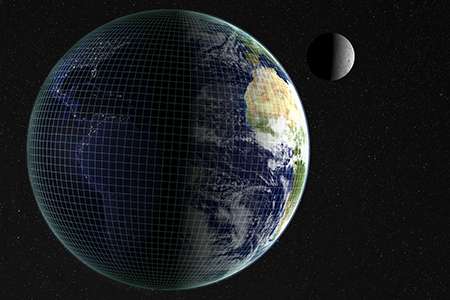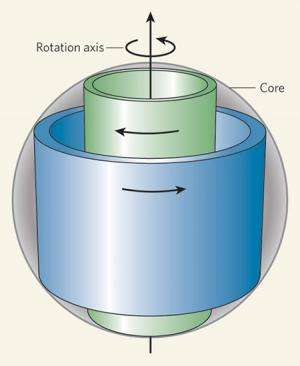July 11, 2013 report
Research pair find 5.9 year cycle of oscillations in length of day

(Phys.org) —A pair of researchers, Richard Holme of the University of Liverpool in the U.K. and Olivier de Viron of the University of Paris, in France has found that the length of Earth's days follows a cyclic oscillation pattern every 5.9 years. As the two describe in their paper published in the journal Nature, the variations in day length were discovered as part of a study examining day-length over the past 50 years.
The time it takes the Earth to spin once around its axis varies by milliseconds on any given day. This is due to the impact of weather patterns, ocean currents and other factors. But the Earth is also subject to other forces that can cause the length of day to vary over the long term or even for short "jumps" of time. In this new effort, the researchers looked at data from the past 50 years and then filtered out those short term forces that cause daily fluctuations in day-length. In so doing, they found what they describe as a ten year "decadally varying trend" a 5.9 year cycle of day-length oscillations and times when the planet seems to jerk, temporarily changing the length of the days that follow.
Unlike the ten year trend (believed to be caused by changes in the Earth's core) and the episodic jerks (scientists have detected 10 such events since 1969) the 5.9 year cycle was unexpected. Every 5.9 years, they claim, the planet undergoes a period of several months where the length of each day is longer or shorter than "normal." The researchers don't know what causes the cycle but suspect it has something to do with the core-mantle boundary.
Scientists are also interested in learning more about the episodic jerks that alter day-length for several months at a time—this new research has revealed that during each event, the Earth's geomagnetic field undergoes a similar effect. Scientists don't know why either occurs, but suspect they are connected.

Research into Earth's day-length changes as well as studies seeking to better understand the true makeup of the planet are not just academic pursuits—gains in understanding are used by geologists and engineers in mining and exploration efforts.
More information: Characterization and implications of intradecadal variations in length of day, Nature 499, 202–204 (11 July 2013) doi:10.1038/nature12282
Abstract
Variations in Earth's rotation (defined in terms of length of day) arise from external tidal torques, or from an exchange of angular momentum between the solid Earth and its fluid components. On short timescales (annual or shorter) the non-tidal component is dominated by the atmosphere, with small contributions from the ocean and hydrological system. On decadal timescales, the dominant contribution is from angular momentum exchange between the solid mantle and fluid outer core. Intradecadal periods have been less clear and have been characterized by signals with a wide range of periods and varying amplitudes, including a peak at about 6?years. Here, by working in the time domain rather than the frequency domain, we show a clear partition of the non-atmospheric component into only three components: a decadally varying trend, a 5.9-year period oscillation, and jumps at times contemporaneous with geomagnetic jerks. The nature of the jumps in length of day leads to a fundamental change in what class of phenomena may give rise to the jerks, and provides a strong constraint on electrical conductivity of the lower mantle, which can in turn constrain its structure and composition.
Journal information: Nature
© 2013 Phys.org


















